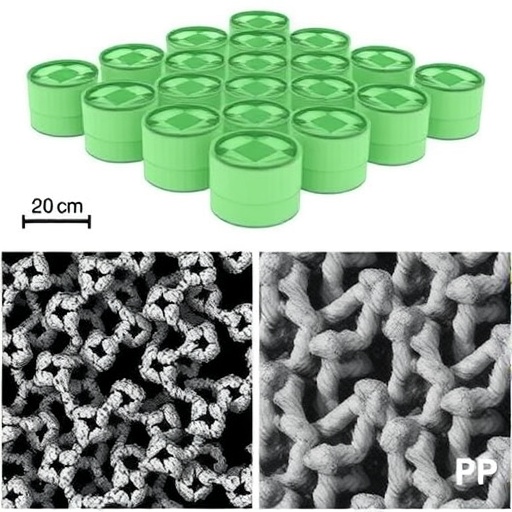Microplastics have emerged as a significant environmental concern, as they pervade ecosystems and pose risks to both wildlife and human health. In an intriguing advance in this field, a recent study led by Sekar et al. seeks to uncover the complex interactions between microplastics and heavy metals, particularly Zinc (ZnII). Given the growing presence of microplastics in the environment, understanding their behavior—especially how they adsorb toxic metals—becomes critical for devising effective remediation strategies. The research focuses on UV-aged polyethylene terephthalate (PET) and polypropylene (PP) microplastics, materials commonly found in various consumer products and waste.
The significance of selecting UV-aged microplastics for this study cannot be understated. Microplastics are subjected to environmental stressors such as sunlight, which can alter their physical and chemical properties. Ultraviolet (UV) radiation, in particular, can induce changes that may increase the surface area’s reactivity and adsorption capacity of microplastics. The work by Sekar et al. raises pertinent questions about how these alterations affect the microplastics’ ability to bind with heavy metals like Zn(II), providing new insights into the fate of pollutants in marine and terrestrial environments.
To examine the adsorption behavior of Zn(II) on UV-aged PET and PP microplastics, the researchers implemented a series of rigorous kinetic and isotherm analyses. Kinetic studies are fundamental, as they elucidate the rate at which Zn(II) ions are absorbed onto microplastic surfaces. Time-dependent experiments reveal that the adsorption process is not instantaneous but evolves over time, suggesting that specific mechanisms may be at play, possibly involving initial rapid adsorption followed by a slower, more gradual phase. These observations provide a nuanced understanding of how Zn(II) interacts with the microplastic substrates.
In addition to kinetic analyses, the researchers conducted isotherm studies to establish the relationship between the amount of Zn(II) adsorbed onto the microplastics and its concentration in the solution. This analysis is crucial for determining the nature of the adsorption sites on microplastics—whether they are homogeneous or heterogeneous—and understanding how various factors influence this relationship. For instance, the choice of isotherm model—be it Langmuir or Freundlich—can greatly influence the interpretation of the data, leading to different implications for environmental behavior.
One of the standout findings from this research is the differential ability of PET and PP microplastics to adsorb Zn(II). Preliminary results indicate that PET may have a more significant affinity for Zn(II) compared to PP. This discrepancy may arise from variances in surface chemistry and structure; PET typically features more polar functional groups than PP, which could enhance interaction with positively charged Zn(II) ions. Such findings emphasize the need for material-specific assessments when evaluating the risks associated with microplastic contamination.
Moreover, the study provides environmental contextualization, indicating that levels of Zn(II) found in many aquatic environments can be concerning, particularly in areas impacted by urban runoff and industrial discharges. With microplastics acting as “sinks” for these toxic metals, they could contribute to the accumulation of Zn(II) in the food chain, ultimately posing risks not only to aquatic organisms but also to humans who rely on these ecosystems for food. The research underscores an urgent need for pollution management strategies that consider the interaction between microplastics and heavy metals.
As the researchers delve deeper into the mechanisms underlying Zn(II) adsorption, they also address factors affecting this process, such as pH, temperature, and ionic strength of the surrounding medium. Each of these parameters plays a pivotal role in influencing how ions interact with microplastic surfaces. Notably, the pH of the environment can dramatically alter the speciation of Zn, affecting its charge and, consequently, its compatibility with different microplastic substrates. Such insights could inform remediation efforts aimed at removing heavy metals from polluted environments where microplastics are prevalent.
Underpinning the entire inquiry is a sophisticated suite of analytical techniques, including scanning electron microscopy (SEM) and energy dispersive X-ray spectroscopy (EDX). These tools not only visualize the microplastics but also provide elemental composition data, enriching the study’s findings and providing a comprehensive view of adsorption phenomena. The technological integration highlights the multidisciplinarity of environmental science, where advancements in imaging and analysis bolster traditional methods.
The research’s implications extend to policymakers and environmental regulators tasked with formulating guidelines on microplastic pollution. By illuminating the interactions between microplastics and heavy metals, the study opens avenues for developing regulatory frameworks that may require stricter controls on plastic waste in environments vulnerable to industrial contaminants. As awareness grows regarding microplastic issues, understanding their role in chemical transport will become more crucial to achieving cleaner water bodies and healthier ecosystems.
In conclusion, the study led by Sekar et al. contributes valuable knowledge to the burgeoning field of microplastic research, exposing the intricate dynamics between microplastics and toxic metals like Zn(II). As the findings unfold, they serve as an invitation for further exploration into various aspects of environmental chemistry, urging the scientific community to delve deeper into the consequences of our plastic dependency. Collectively, these themes paint a comprehensive picture of not only the current state of microplastic research but also highlight the path forward in tackling an emerging environmental challenge.
The continuous cycling of microplastics through ecosystems calls for more attention to their material properties and interactions. Well-designed studies can illuminate this interaction further, revealing not only risks associated with heavy metal adsorption but potentially affirming mitigation approaches that could minimize environmental contamination more effectively. In this evolving dialogue between science and environmental policy, Sekar et al.’s research could play a pivotal role in shaping future initiatives aimed at understanding and managing microplastic pollution.
Subject of Research: Adsorption behavior of Zn(II) on UV-aged PET and PP microplastics.
Article Title: Unraveling the adsorption behavior of Zn(II) on UV-aged PET and PP microplastics: kinetic and isotherm analyses.
Article References: Sekar, V., Laxmanarao, M., Sounderarajan, S. et al. Unraveling the adsorption behavior of Zn(II) on UV-aged PET and PP microplastics: kinetic and isotherm analyses. Environ Sci Pollut Res (2025). https://doi.org/10.1007/s11356-025-37100-0
Image Credits: AI Generated
DOI: 10.1007/s11356-025-37100-0
Keywords: Microplastics, Zn(II), PET, PP, adsorption, environmental pollution, kinetic analysis, isotherm analysis.




